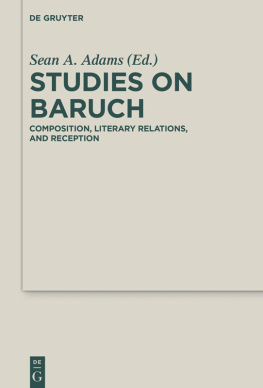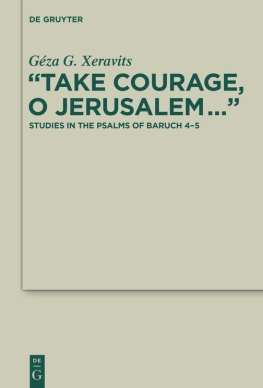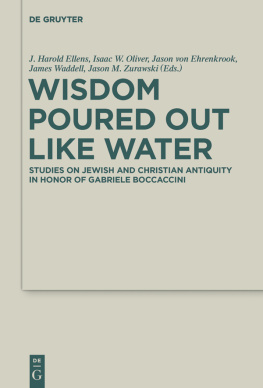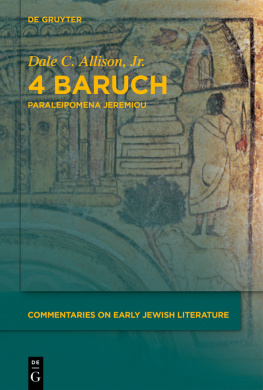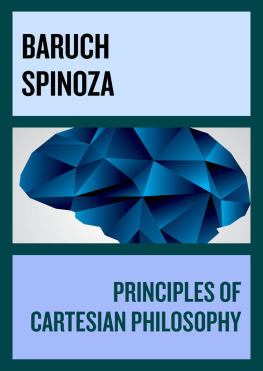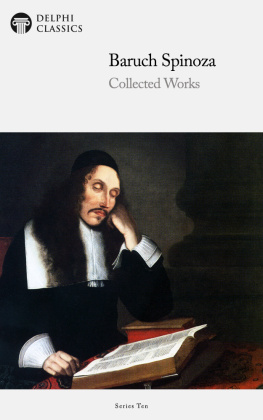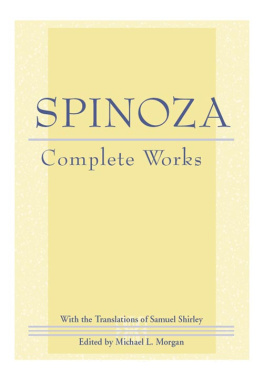Studies on Baruch
Guide

Studies on Baruch
Deuterocanonical and Cognate Literature Studies

Edited by
Friedrich V. Reiterer, Beate Ego and Tobias Nicklas
Volume 23

ISBN 978-3-11-036294-7
e-ISBN (PDF) 978-3-11-036427-9
e-ISBN (EPUB) 978-3-11-039160-2
ISSN 1865-1666
Library of Congress Cataloging-in-Publication Data
A CIP catalog record for this book has been applied for at the Library of Congress.
Bibliographic information published by the Deutsche Nationalbibliothek
The Deutsche Nationalbibliothek lists this publication in the Deutschen Nationalbibliografie; detailed bibliographic data are available on the Internet at http://dnb.dnb.de.
2016 Walter de Gruyter GmbH, Berlin/Boston
www.degruyter.com
Acknowledgements
As in any project, thanks are due to a wide range of people. First I would like to thank Tobias Nicklas for his invitation to edit this volume in de Gruyters Deuterocanonical and Cognate Literature Studies series. I would also like to thank the staff at de Gruyter, especially Albrecht Dhnert, as well as the other series editors for their assistance throughout this project.
I am very grateful for the British Academy, whose funding allowed me to dedicate the needed time to this project.
Finally, thanks are due to my family who support me in my academic endeavours, especially my wife Megan and my son William.
The completion of this manuscript coincides with the birth of my nephew, Ethan James Adams and it is with great delight that I dedicate this book to him and his parents Morgan and Martha: May he always be to you a blessing.
August 2015
Sean A. Adams
Glasgow, UK
Abbreviation
All abbreviations in this book are taken from Patrick H. Alexander, et al., The SBL Handbook of Style: For Biblical Studies and Related Disciplines, Second Edition (Atlanta: SBL Press, 2014).
Sean A. Adams
Introduction
The chapters in this volume come from individual studies by the various authors. The uniting feature amongst them is the recognition that insufficient attention has been paid to Baruch and that much more scholarship needs to be undertaken in order to understand more fully this neglected book.
This is the first volume of collected essays that focus exclusively on Baruch and it is clear from the range of subjects that much more could have been covered. The chapters explore a variety of topics including reception, translation, and historical placement, though by far the most common topic is the relationship between Baruch and Jewish Scripture. In general, the studies that re-investigate the literary and theological perspectives of Baruch are focused on specific sections of the text. As is well known amongst those who are interested in Baruch, one of the main issues is determining the interrelated nature of the component parts (1:114; 1:153:8; 3:94:4; and 4:55:9). Although no chapter seeks to tackle more than one section, the collective findings from the various articles show strong similarities in their conclusions and suggest that an innovative approach to the use of Scripture may be a uniting feature of the work.
For example, one of the common themes found throughout this volume, especially amongst the essays examining Baruchs relationship with Jewish Scripture, is that the author/compiler of Baruch is creative. Although traditionally it may have been fashionable to deride the author of Baruch for merely repackaging existing texts, it is recognised in these studies that there is substantial creativity in the selection of which texts to draw upon and in their arrangement. Just because the author of Baruch made use of Jeremiah, Isaiah, Deuteronomy, Job, Psalms, and other texts does not mean that he did so in an uncritical manner or that he adopted whole cloth the perspective of his source text. The findings of this volume indicate that the author was highly selective and nuanced in his appropriation of texts and that he selected his models with care.
In addition to the recognition of Baruchs literary creativity, there is agreement amongst the writers who contributed to this volume that Baruch contains substantial theological ingenuity also. The engagement by Baruch of pre-existing scriptural texts is not one of blind conformity. Rather, the author of Baruch tailors the content and theological thrust of his text to his perceived situation. Theological ideas embedded in Scripture are reformulated and presented from fresh perspectives. Similarly, some theological ideas that were latent in the texts are now explicitly and more fully developed. Far from being entirely dependent on scriptural texts, the author of Baruch made new and original literary and theological contributions. The chapters in this volume that investigate these topics are part of a larger trend in scholarship, though it is clear that more can and should be done in this regard.
In addition to the chapters that investigate the literary and theological creativity of the author, a few chapters look to the reception of Baruch; how it has been translated and how it has been used in religious settings. This is an even less explored aspect of Baruch, but one that is equally fruitful. For example, what role did Baruch play in Jewish and Christian liturgy? What place, if any, did it have in the creation and development of theology? Why is it that it is predominantly the wisdom section of Baruch (3:94:4) that is used by Christian writers as opposed to other sections? Each of these questions opens up new ways of understanding the text of Baruch and the chapters in this volume provide new opportunities to understand Baruch better in its different historical contexts.
The above discussion provides a brief introduction to the macro-level themes and ideas discussed in the volume. The remainder of this introduction offers summaries of the different chapters. The first study in the volume is Simulated Similarities by Georg Fischer. In his chapter Fischer unpacks the role and function of the authors selection of Baruch as the dominant character in Baruch 1:1. Fischer argues that the Book of Baruch displays three formative ideas: it emphasizes the importance of its main figure, Baruch; it indicates the close relationship between the Books of Baruch and Jeremiah; and, third, Baruch differs from Jeremiah by going beyond by expanding certain Jeremianic ideas, thus creating its own agenda. The identification of these similarities and differences allows for an insightful reading of the text that recognizes Baruchs relationship with Jeremiah, but also highlights elements where the author adopted different ideas.
In , A Glimpse of the Emerging Synagogue in the Book of Baruch, Michael Floyd mines the text of Baruch for insights into the function and structure of the synagogue in the second century BCE. Floyd determines that Baruch has the ability to shed light on particular questions, such as synagogue sanctity and the practice of communal prayer. More generally, Floyd concludes that Baruch shows that some local assemblies in the diaspora envisioned the institutionalization of certain penitential practices which they considered complementary to Jerusalems sacrificial cult. Groups that were synagogues in this sense thus saw themselves as outlying extensions or satellites of the temple. Along the way, Floyd re-evaluates the scholarly theories of the dating of the text and concludes that Baruch was most likely written prior to the time of Antiochus IV Epiphanies (i. e., in the early second century BCE).

